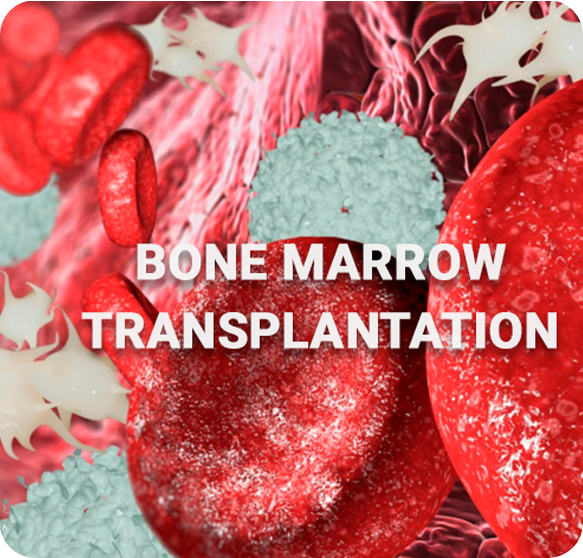BONE MARROW TRANSPLANTATION
BONE MARROW TRANSPLANTATION
A bone marrow transplant is a procedure to replace diseased or destroyed bone marrow with healthy bone marrow stem cells. Bone marrow is the soft, fatty tissue inside the bones. The bone marrow produces blood cells. Stem cells are immature cells in the bone marrow that give rise to all of the different blood cells.
![]() Before the transplant process : chemotherapy, radiation, or both may be given. This may be done in 2 ways:
Before the transplant process : chemotherapy, radiation, or both may be given. This may be done in 2 ways:
- Ablative (myeloablative) treatment- High-dose chemotherapy, radiation or both are given to kill any cancer cells. This also kills all healthy bone marrow that remains and allows new stem cells to grow in the bone marrow.
- Reduced intensity treatment also called a mini transplant. Lower doses of chemotherapy and radiation are given before a transplant. This allows older people and those with other health problems to have a transplant.
![]() There are three kinds of bone marrow transplants:
There are three kinds of bone marrow transplants:
- Autologous bone marrow transplant. The term auto means self. Stem cells are removed from you before you receive high-dose chemotherapy or radiation treatment (similar to blood donation). The stem cells are stored in a freezer. After high-dose chemotherapy or radiation treatments, stems cells( essentially pt’s own blood) are infused back to make normal blood cells. This process is called a Auto transplant (or Auto BMT).
- Umbilical cord blood transplant. This is a type of allogeneic transplant. Stem cells are removed from a newborn baby’s umbilical cord right after birth. The stem cells are frozen and stored until they are needed for a transplant.
- Allogeneic bone marrow transplant. The term allo means self. Stem cells are removed from another person, called a donor. Most times, the donor’s genes must at least partly match patients genes. Special tests are done to see if a donor is a good match. A brother or sister is most likely to be a good match. Sometimes parents, children and other relatives are good matches. Donors who are not related to you, yet still match, may be found through national bone marrow registries.
The stem cells are delivered into your bloodstream usually through a tube called a central venous catheter. The process is similar to getting a blood transfusion. The stem cells travel through the blood into the bone marrow.
![]() Donor stem cells can be collected in two ways:
Donor stem cells can be collected in two ways:
- Bone marrow harvest. This minor surgery is done under general anesthesia. This means the donor will be asleep and pain-free during the procedure. The bone marrow is removed from the back of both hip bones. The amount of marrow removed depends on the weight of the person who is receiving it.
- Leukapheresis :First, the donor is given several days of Growth Factor injections to help stem cells increase and move from the bone marrow into the blood. The donor is then connected to a leukapheresis machine where the person’s blood is continually being circulated and WBCs are filtered ( similar to the setup when a person is giving blood for SDP platelets in blood bank). The part of white blood cells that contains stem cells is then separated in a machine and filtered out to be later given to the recipient. The red blood cells are returned to the donor.
- Bone marrow transplantations are used to treat people with certain diseases like
- Leukemia
- Lymphoma
- Multiple myeloma

